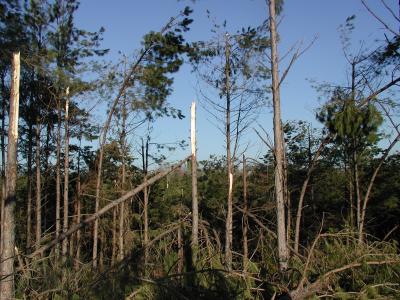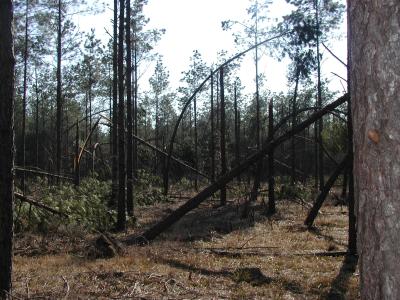Salvaging Timber

Following disasters, woodland owners are sometimes faced with making a decision about what to do with trees that have been damaged. There are some situations where it is possible to recover a portion of the loss through tax deductions. To qualify for these deductions the following steps need to be followed.
Recovering the Value of Storm Damaged Timber From Taxes
To be allowed as a casualty loss deduction on your Federal Income Tax Return, a loss must be caused by natural or other external factors acting in a sudden, unexpected and unusual manner.
The language in Section 165(c)(3) of the Internal Revenue Code indicates that fires, storms and shipwrecks are casualty losses. The term has been limited by the courts and IRS to these and similar occurrences such as windstorm, sleet and hail.
Determining the Amount of Deductible Loss
If your timber is destroyed by fire, ice storm or other casualty, your deductible loss is the allowable basis (value invested) in the timber destroyed minus any insurance or other compensation received. Timber damaged, but still fit for market, should be salvaged if possible.
If a gain results from the salvage activity, there is no casualty loss with respect to the salvaged timber. Determine your gain or loss from the salvage cutting, sale or other disposal as you would for timber sales in general.
If you are not able to salvage the timber after making a bonafide attempt to do so and claim a loss deduction, you should keep a record of your efforts to show that the timber was not salvageable.
Determining Volume of Timber Destroyed

To claim a loss deduction, the single identifiable object damaged or destroyed must be identified. For timber, this is expressed in terms of the specific units destroyed. The units of measurement used should be those used to maintain your timber accounts, such as board feet, cords, cubic feet or tons.
The number of units of timber destroyed must be established by fair and reasonable measurement to justify a deduction. You may wish to employ a consulting forester to cruise the timber if the area is extensive and much work is involved. Your county forester or other representative of the Arkansas Forestry Commission may be able to furnish you with an estimate of the quantity destroyed.
Determining Basis of Timber Destroyed
Determine the basis (value invested) in timber destroyed as you would for a timber sale. First, determine the depletion unit by dividing the adjusted basis for depletion as shown in your timber account by the quantity of merchantable timber in the account.
Then, multiply the depletion unit by the number of units destroyed to find the amount allowable as a loss. The volume used to calculate the depletion unit for the loss should include adjustments for growth for the year of the casualty but is not reduced by the volume of timber destroyed. If your timber has no basis, you will not have a deductible loss.
Year of Deduction
A loss arising from a casualty generally is deducted in the year in which the casualty occurs. This is true even if you have not yet settled a reimbursement claim or have not received an agreed upon insurance settlement or other compensation.
If a claim for reimbursement has been made, and you think you will recover all or part of the loss even though you have not yet received payment by the time the tax return for the year of the casualty is due, reduce the reported loss by the amount you expect to recover.
Landowners who have suffered significant timber losses should contact a knowledgeable tax attorney familiar with timber tax especially tax losses from storm damaged timber.
Publications
| Source | Title |
|---|---|
| FSA5017 | Landowner’s Guide to Determining Weight and Value of Standing Pine Trees |
| FSA5020 | Income Tax Deductions for Storm-Damaged Timber |
| FSA5021 | Landowner’s Guide to Determining Weight and Value of Standing Hardwood Trees |
| FSA5028 | Timber Price Reporting: How Do I Get a Report and What Does It Mean? |
| FSA5025 | Timber Income and the Federal Income Tax |
| The Forest Landowners Guide to the Federal Income Tax (Ag Handbook #731) National Timber Tax Website |
|
| Instructions for IRS Form T (Timber) Internal Revenue Service (IRS) |
Additional Resources
| Source | Title |
|---|---|
| Timber Price Report Forestry | Environment & Nature | University of Arkansas Extension |
|
| Southern Regional Extension Forestry Office Facilitates programming among the thirteen Extension Forest Resources units in the southern United States and the USDA Forest Service. |
|
| National Timber Tax Website Tax Management for Timberland Owners |